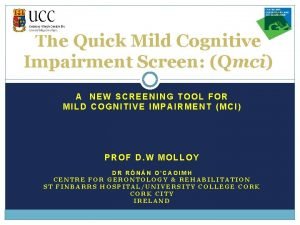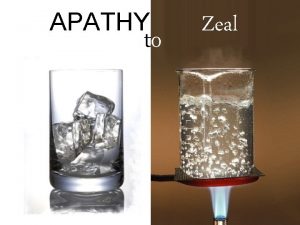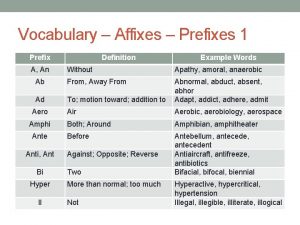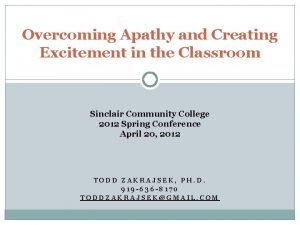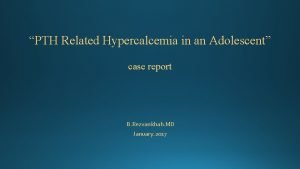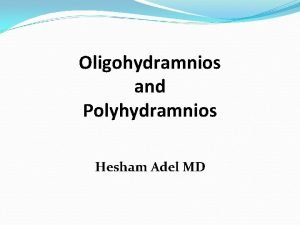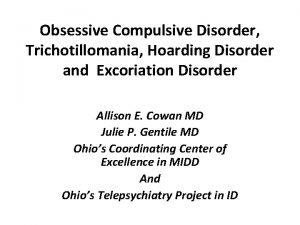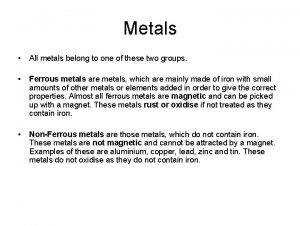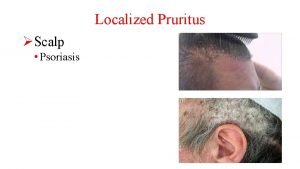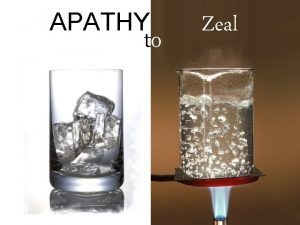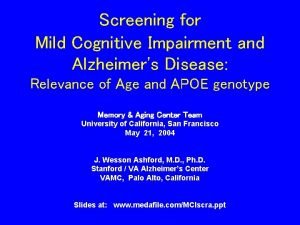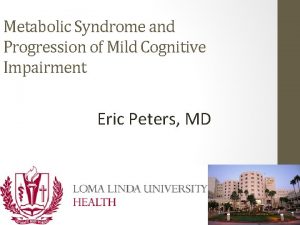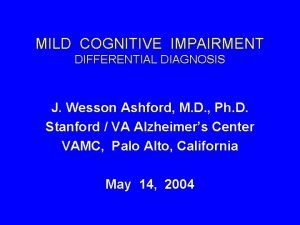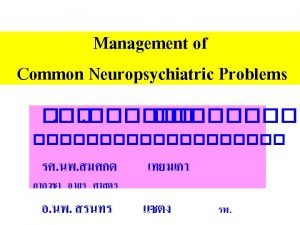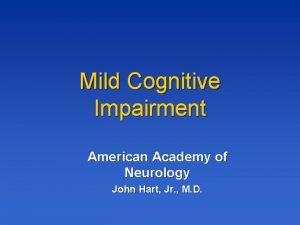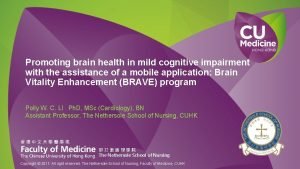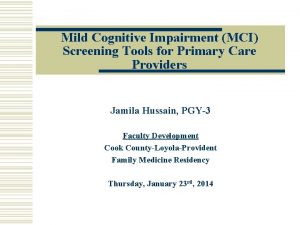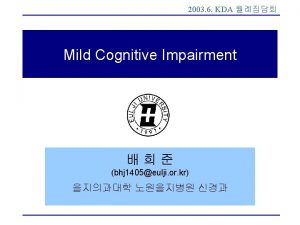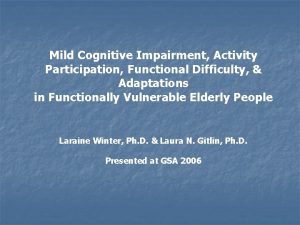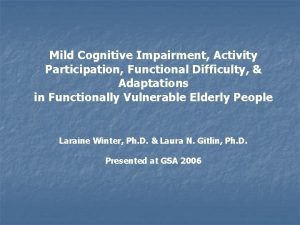Apathy and Leukoaraiosis in Mild Cognitive Impairment and
























- Slides: 24

Apathy and Leukoaraiosis in Mild Cognitive Impairment and Alzheimer’s Disease: Multicenter Diagnostic Criteria according to the Latest Studies. Carmen M Sarabia-Cobo. University of Cantabria Spain

2

Index • • • Introduction Objetives Method Results Discussion/Conclusions 3

Introduction • Alzheimer’s disease (AD) is the leading cause of dementia and is characterized by a progressive decline of cognitive function, which typically begins with memory impairment. 4

Introduction • The latest recommendations by the National Institute of Neurological Disorders and Communication and the Association of Related Alzheimer’s Disease in the United States (NINCDSADRDA) for the diagnosis of AD disorders and Mild Cognitive Impairment (MCI) emphasize the importance of early detection, broadening diagnostic criteria to items such as biomarkers, neuroimaging of specific injuries, and a battery of psychological tests that is as complete as possible. 5

Introduction Given the fact that MCI is a taxonomy that has become particularly relevant in recent years and based on the ever-growing literature on the subject that speaks of a high percentage of patients progressing to AD, it is interesting to look for factors that may influence the evolution towards dementia in order to establish early screening and therapeutic measures. 6

Introduction The presence of leukoaraiosis and the high prevalence of apathy have been addressed together in very few studies. Our research is a pioneer study in our country as it addresses the prevalence of both processes in patients with MCI and AD according to recent consensus criteria that have been developed for the diagnosis of apathy, MCI, and AD. 7

Introduction Apathy and leukoaraiosis are mostly detected in asymptomatic individuals over 60 and in subjects with cognitive impairment, particularly in cases of cerebrovascular disease or vascular risk factors for ischemic stroke. 8

Leukoaraiosis The term leukoaraiosis is a nonspecific radiological term. Denotes patches of hypo- or hyperintensity mainly in periventricular white matter and subcortical regions. Are also known as nonspecific white matter changes and small vessel ischemia. 9

Leukoaraiosis 10

Leukoaraiosis is therefore a finding of heterogeneous neuroimaging. There is not yet a clear consensus in the scientific community for its correct identification. There is evidence of a significant relationship between leukoaraiosis and impaired cognitive functions. There are few studies linking leukoaraiosis and dementia. 11

Apathy • Of the possible emotional affective disorders that can present with dementia, the most prevalent is apathy. • Can be defined as a persistent deficit of motivation, a lack or decrease in feelings, emotions, or interests that give rise to a significant reduction in self-generated goal directed behavior. 12

Apathy Is the most frequent symptom in neuropsychiatric AD and other dementias, and is associated with increased cognitive and functional impairment and a high burden on the caregiver. 13

Apathy A study from 2008 developed a set of several international associations to establish a consensus on the diagnostic criteria for apathy, mainly in AD cases. 14

Objective Following the new consensus on leukoaraiosis and apathy, especially in cases of dementia, this study was proposed with the intent of establishing the prevalence and possible association of leukoaraiosis and apathy in two clinical groups, one with MCI (prodromal state as possible AD) and another with AD institutionalized in seven nursing homes in Spain. 15

Method • Cross-sectional, descriptive, multicenter study. • Sample: 109 patients AD and 59 MCI. Residents in 5 nursing homes. • Criteria inclusion/exclusion. • Variables: sociodemographic, aphaty (NPIapathy subscale), leukoaraiosis (MRIs, Fazekas scale), dependence (Barthel Index), Mini. Mental (MEC). • Data collection was carried out during 2012 and 2013. 16

Results 17

Results 18

Results 19

Results • The existence of a positive correlation between age and leukoaraiosis (rs = 0. 567, p = 0. 00) but not between age and apathy (rs = 0. 236, p = 0. 085) was observed. • A correlation between apathy and leukoaraiosis (rs = 0. 478, p = 0. 01) was also found. In addition, the results of the correlation between the stage of AD and apathy were significant (rs = 0. 568, p = 0. 00), as were those between AD and the stage of leukoaraiosis (rs = 0. 654, p = 0. 00). • Regarding the presence of leukoaraiosis and MEC (rs = 0. 685, p < 0. 05), a negative correlation between apathy and MEC (rs = 0. 425, p < 0. 05) was also found. 20

Discussion/Conclussions • Our results showed a high prevalence of leukoaraiosis and apathy in AD patients and to a lesser but still significant extent in patients with MCI. • Apathy and leukoaraiosis negatively correlated with patients’ scores using MEC, indicating greater cognitive apathy and increased presence of leukoaraiosis impairment in these patients. 21

Discussion/Conclussions • These results are consistent with the findings of other studies that found a high prevalence of apathy and leukoaraiosis in patients with dementia. • Different researches suggested that apathy in AD is a marker of evolution characterized by a more rapid progression of cognitive, functional, and emotional impairment compared to patients without apathy. 22

Conclussions • The presence of apathy and leukoaraiosis is associated with cognitive impairment and may prove to be a predictor of future dementia through the study of populations with MCI. 23

carmen. sarabia@unican. es @C_Sarabia_Cobo 24
 Quick mild cognitive impairment screen
Quick mild cognitive impairment screen Hirarki diagnosis gangguan jiwa
Hirarki diagnosis gangguan jiwa Kode icd gangguan perilaku amoral
Kode icd gangguan perilaku amoral Apathy word surgery
Apathy word surgery Etymology of apathy
Etymology of apathy Apathy
Apathy Belong employee engagement
Belong employee engagement A/an prefix
A/an prefix Apathy is the solution
Apathy is the solution Apathy word origin
Apathy word origin Apathy in a sentence
Apathy in a sentence Apathy etymology
Apathy etymology Cognitive and non cognitive religious language
Cognitive and non cognitive religious language Seltzer water and all sodas contain a very mild
Seltzer water and all sodas contain a very mild Say the color not the word
Say the color not the word Secondary alcohol oxidation
Secondary alcohol oxidation Mild psychosis
Mild psychosis Familial hypocalciuric hypercalcemia
Familial hypocalciuric hypercalcemia None mild moderate severe
None mild moderate severe Polyhydramnios causes
Polyhydramnios causes Ocd obsessive thoughts
Ocd obsessive thoughts Neurocognitive disorders
Neurocognitive disorders Mild steel example
Mild steel example Crater
Crater Mild hepatic steatosis
Mild hepatic steatosis
